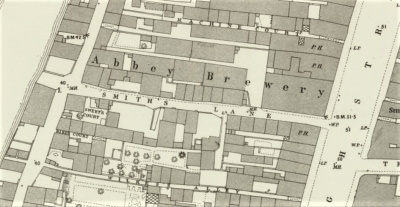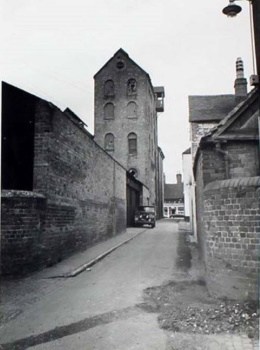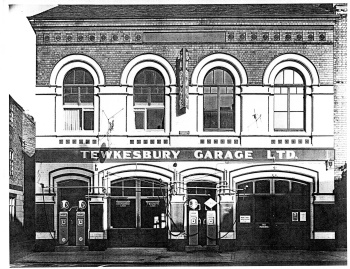Smiths Lane: An Industrial Site
to Expand
Smiths Lane used to be at the centre of the industrial life of Tewkesbury, being one of the routes for moving goods from the riverside to the High Street and beyond. Opposite the bottom of the lane, on the Mill Avon, there was a gap in the warehouses giving access to the river, and probably a busy wharf for moving goods from water to cart and vice-versa.
In the early eighteenth century, Smiths Lane was Lawrells Lane. The Smith it is now named for is said to be a blacksmith’s shop on the corner of what is now Poundland. In 1836 there were twenty-four cottages in the lane, interspersed with coal yards, warehouses and stables. Some were extensive operations and residents often complained about the nuisances caused. In 1831, the contents of Mr Whitehorn’s coal yard; 300 tons of Bilston coal and 1,000 bushels of coke, was sold by auction. A lot of coal was shipped into the town.
On what is now the Britannia’s extension and beer garden there were five cottages. Behind them was a lane which gave access to the backs of High Street properties almost to Wilkes Alley. In addition, the lane had its own court, Sweet’s, at the Back of Avon end. It contained a further six cottages, on land owned by the Russell Almshouses charity. In 1844, Mrs Drew bought the entire court for £268.
to Expand
People didn’t stay long in the lane; names changed from census to census. Alongside watermen, the predominant occupation was stocking making, which became a very precarious trade indeed. One of their number, James Woodward, succumbed to cholera in 1849. In 1841, Sarah Bishop was recorded as a beerhouse keeper. Maybe her house was the Hen and Chickens reputed to have been in Smiths Lane?
The area now occupied by Poundland slowly became an area of light industry and warehousing as cottages were converted or demolished. By 1862, Joseph Firkins owned numbers 81 to 84 High Street from where he ran what must have been a very extensive wine and spirit business. Mr Firkins was one of a group of men who monopolised the brewing and spirits businesses in Tewkesbury. They are worthy of a book of their own. By 1873, a ‘newly and well-built brewery’, three storeys high, occupied the whole length of the lane, trading as the Abbey Brewery.
As brewing transitioned from small brewhouses towards the global companies we have today, the three large Tewkesbury breweries, including the Abbey, merged and in 1896 the whole enterprise was taken over by Arnold Perrett, of Wickwar. Rationalisation meant the end of local brewing and the premises was closed in 1908.
to Expand
For the new, burgeoning, motor industry, the timing was perfect. The old brewery building was eminently suitable as a garage, and by 1911 Sidney Alldridge had opened the Tewkesbury Garage and was an official repairer to the RAC. This business grew and developed, repairing and selling cars, motorbikes and eventually outboard motors. In 1920, petrol storage tanks were installed. A highlight was a visit by the famous Amy Johnson in 1938, on a tour promoting Morris cars. Like the brewery before, though, the garages in Tewkesbury consolidated and Tewkesbury Garage joined forces with Tewkesbury Car mart, at 101 High Street. In 1966, Bill Allen, a motor dealer from Cheltenham, took over the businesses and they left the High Street.
The jumble of buildings and yards behind the garage were in assorted ownerships once the brewery had closed. The Council rented a yard, John Hall ran a coal business, Messrs Gopshill Brown had a sack depot and Mr Matthews’ slaughterhouse was the last in the town. Mr Bishton opened a workshop making aircraft instruments. Businesses came and went.
In 1942, Tewkesbury’s Sea Cadet unit was founded and opened in a building in Smiths Lane, where they stayed until 1966, when the whole area, from Tewkesbury Garage to Back of Avon was purchased and demolished to create the supermarket building and car park which is there today.
On the other side of the lane, Sweet’s Court and the five cottages behind the Britannia survived until the late sixties when they too succumbed to the mania for development which had hit the town. Copying what had happened on the other side of the lane, the High Street shops next to the Britannia were purchased to build another supermarket, Liptons, and all the land as far as the Back of Avon to build Hanover Court. The Britannia was extended down Smiths Lane to take up the area of the five cottages and everything else was swept away. To their credit, these developers rebuilt the frontage of what is now Coffee #1 and Shoezone to mimic what was there before. The rear is a scruffy wasteland, though.
Smiths Lane is a main footpath between the river and town. It has been improved a little with proper paving, but it must be a prime candidate for some imaginative upgrading.



Comments